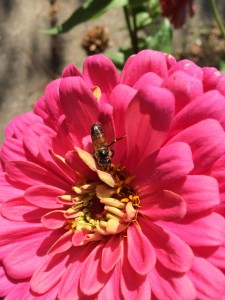Many of us are all ready suffering from bee withdrawal. The weather is such that we can no longer check things in the hive (whether or not they ever really needed to be checked!) …. or even watch bees go in and out. I miss my bees.
October will hopefully bring some delightfully sunny days when the winged darlings can still secure stores from the remaining asters, goldenrod and any enduring annuals. (Recently I spied a dandelion in our yard. I wanted to put a flag next to it to help them find it.) But because food sources are fading, my light-by-weight colonies continue to receive 2:1 sugar syrup, mixed heavily with honey we obtained from honeybee extractions, to help them fill their cupboards.
My zinnias are slowing down, but on sunny days, they’re still well visited.
I will so miss interacting with my bees. Missing them however will be dwarfed by my worrying about them. (Not that that does much good.) If you’re joining me in worrying about your bees, or are simply curious about what goes on in the winter cluster, here’s an excerpt from two bee experts that is enlightening.
The Winter Cluster
Excerpted from Honey Bee Biology and Beekeeping, Revised Edition, p. 216, by Caron & Connor
“By the relatively simple behavior of clustering, the social honey bee is able to generate and conserve enough heat to survive whatever most winters have in store. A spherically-shaped brood area and clustering behavior assists bees in maintaining a basic hive temperature in the 59˚F (15˚C) range, regardless of outside temperature…
Bee clusters have a definite structure. The outer portion is an insulating shell of tightly clustered bees, varying from one to three inches (2.5 to 7.5 cm) thick. For warmth and to form the shell, the bees fill the spaces between the parallel combs and occupy empty cells in the comb. Bees on the outside are too cold to move but can protrude the sting if disturbed.
Within the center of the cluster, the bees are warmer and less crowded. They move about taking care of the brood and their queen, as well as performing routine comb maintenance. Heat generated by adult bee movement, moving wing muscles and the brood metabolism provides the heat that keeps the bees warm. Considerable metabolic water vapor is released. Since bees use winter stores most efficiently at 57˚F (14˚C), the amount of honey stores they need to consume to maintain a winter cluster is small. The lowest temperature which a colony can survive depends on food availability and the number of bees. When they are broodless, the temperature in the center of the cluster is around 70˚F (21˚C) while the manageable temperature range is approximately 54 to 94˚F (12 to 34˚C). When brood is present, the temperature will be at the upper limit.
During moderate winter temperatures, the bees move honey from storage cells at the exterior closer to the cluster. During colder spells, the cluster becomes more compact from the simple behavior of individual bees moving inward to exchange position with warmer bees as their body temperature becomes too cold. As winter progresses, the cluster moves upward in the hive, seeking to maintain constant contact with stored honey.
There is a practical limit to which bees can contract their cluster. A portion of the cluster must be in contact with honey stores at all times since this is the fuel needed to run the muscles which generate the heat. Heat loss is proportional to the number of bees in the cluster. Smaller clusters are less likely to survive compared to larger clusters. In a study in Scotland, a bee colony of 18,000 bees lost 35% of its population while a colony of 4,500 lost fully 85% of the adults during the winter.”
Thanks to Wicwas Press for widely sharing that excerpt via a recent email.
And beekeepers, when we still have days to get in the hive, please mull over what the winter clustering behavior means to your bees. Some questions to consider:
- Will you help bees maintain temperature by windbreaks, or perhaps wrapping the hive?
- Do you have an emergency feed ceiling if they get to the top before spring comes?
- If you have a weak colony and a strong one, is it appropriate to combine them?
- Those poor bees on the outside of the cluster, “too cold to move”—do you have an absorbent ceiling so the moisture from their generating heat doesn’t condense and drop back down on them?
It is hard to say good-bye to bees for the winter … but even harder if they don’t survive to say hello to come spring.
